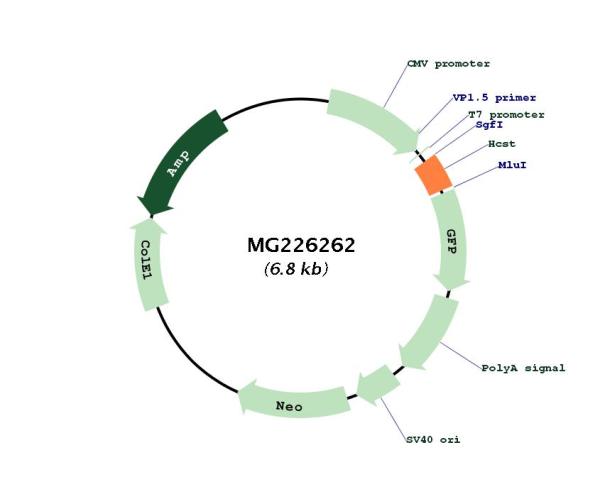Hcst (NM_011827) Mouse Tagged ORF Clone
CAT#: MG226262
- TrueORF®
Hcst (tGFP-tagged) - Mouse hematopoietic cell signal transducer (Hcst), (10ug)
ORF Plasmid: DDK
Lentiviral Particles: DDK w/ Puro mGFP w/ Puro
AAV Particle: DDK
"NM_011827" in other vectors (4)
Specifications
| Product Data | |
| Type | Mouse Tagged ORF Clone |
| Tag | TurboGFP |
| Symbol | Hcst |
| Synonyms | DAP10; KAP10 |
| Vector | pCMV6-AC-GFP |
| E. coli Selection | Ampicillin (100 ug/mL) |
| Mammalian Cell Selection | Neomycin |
| Sequence Data |
>MG226262 representing NM_011827
Red=Cloning site Blue=ORF Green=Tags(s) TTTTGTAATACGACTCACTATAGGGCGGCCGGGAATTCGTCGACTGGATCCGGTACCGAGGAGATCTGCC GCCGCGATCGCC ATGGACCCCCCAGGCTACCTCCTGTTCCTGCTTCTGCTCCCAGTGGCTGCAAGTCAGACATCGGCAGGTT CCTGCTCCGGATGTGGGACTCTGTCTCTGCCACTCCTGGCAGGCCTAGTGGCTGCAGATGCGGTCATGTC ACTCCTAATTGTAGGGGTGGTGTTTGTATGTATGCGCCCACACGGCAGGCCTGCCCAAGAAGATGGTAGA GTCTACATCAACATGCCTGGCAGAGGC ACGCGTACGCGGCCGCTCGAG - GFP Tag - GTTTAA >MG226262 representing NM_011827
Red=Cloning site Green=Tags(s) MDPPGYLLFLLLLPVAASQTSAGSCSGCGTLSLPLLAGLVAADAVMSLLIVGVVFVCMRPHGRPAQEDGR VYINMPGRG TRTRPLE - GFP Tag - V |
| Restriction Sites |
SgfI-MluI
Cloning Scheme for this gene
Plasmid Map

|
| ACCN | NM_011827 |
| ORF Size | 237 bp |
| OTI Disclaimer | The molecular sequence of this clone aligns with the gene accession number as a point of reference only. However, individual transcript sequences of the same gene can differ through naturally occurring variations (e.g. polymorphisms), each with its own valid existence. This clone is substantially in agreement with the reference, but a complete review of all prevailing variants is recommended prior to use. More info |
| OTI Annotation | This clone was engineered to express the complete ORF with an expression tag. Expression varies depending on the nature of the gene. |
| Product Components | The ORF clone is ion-exchange column purified and shipped in a 2D barcoded Matrix tube containing 10ug of transfection-ready, dried plasmid DNA (reconstitute with 100 ul of water). |
| Reconstitution | 1. Centrifuge at 5,000xg for 5min. 2. Carefully open the tube and add 100ul of sterile water to dissolve the DNA. 3. Close the tube and incubate for 10 minutes at room temperature. 4. Briefly vortex the tube and then do a quick spin (less than 5000xg) to concentrate the liquid at the bottom. 5. Store the suspended plasmid at -20°C. The DNA is stable for at least one year from date of shipping when stored at -20°C. |
| Reference Data | |
| RefSeq | NM_011827.3, NP_035957.2 |
| RefSeq Size | 452 bp |
| RefSeq ORF | 240 bp |
| Locus ID | 23900 |
| UniProt ID | Q9QUJ0 |
| Cytogenetics | 7 17.45 cM |
| Gene Summary | Transmembrane adapter protein which associates with KLRK1 to form an activation receptor KLRK1-HCST in lymphoid and myeloid cells; this receptor plays a major role in triggering cytotoxicity against target cells expressing cell surface ligands such as MHC class I chain-related MICA and MICB, and UL16-binding proteins (ULBPs); these ligands are up-regulated by stress conditions and pathological state such as viral infection and tumor transformation. Functions as docking site for PI3-kinase PIK3R1 and GRB2. Interaction of ULBPs with KLRK1-HCST triggers calcium mobilization and activation of the PIK3R1, MAP2K/ERK, and JAK2/STAT5 signaling pathways. Both PIK3R1 and GRB2 are required for full KLRK1-HCST-mediated activation and ultimate killing of target cells. In NK cells, KLRK1-HCST signaling directly induces cytotoxicity and enhances cytokine production initiated via DAP12/TYROBP-associated receptors. In T-cells, it provides primarily costimulation for TCR-induced signals. KLRK1-HCST receptor plays a role in immune surveillance against tumors and is required for cytolysis of tumors cells; indeed, melanoma cells that do not express KLRK1 ligands escape from immune surveillance mediated by NK cells.[UniProtKB/Swiss-Prot Function] |
Documents
| Product Manuals |
| FAQs |
| SDS |
Resources
Other Versions
| SKU | Description | Size | Price |
|---|---|---|---|
| MC209680 | Hcst (untagged) - Mouse hematopoietic cell signal transducer (Hcst), (10ug) |
USD 150.00 |
|
| MR226262 | Hcst (Myc-DDK-tagged) - Mouse hematopoietic cell signal transducer (Hcst) |
USD 150.00 |
|
| MR226262L3 | Lenti ORF clone of Hcst (Myc-DDK-tagged) - Mouse hematopoietic cell signal transducer (Hcst) |
USD 450.00 |
|
| MR226262L4 | Lenti ORF clone of Hcst (mGFP-tagged) - Mouse hematopoietic cell signal transducer (Hcst) |
USD 450.00 |
{0} Product Review(s)
Be the first one to submit a review






























































































































































































































































 Germany
Germany
 Japan
Japan
 United Kingdom
United Kingdom
 China
China

